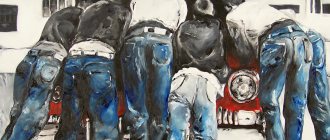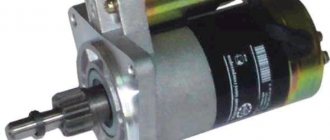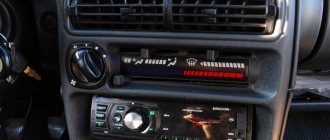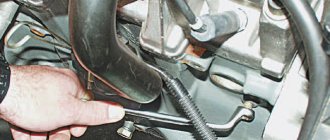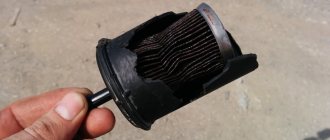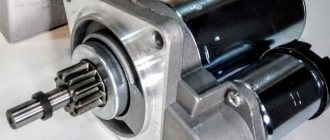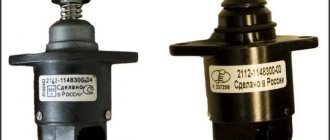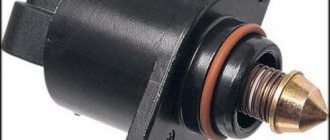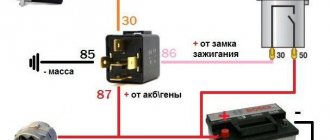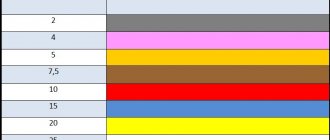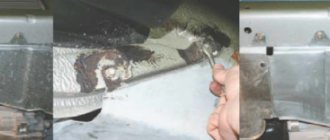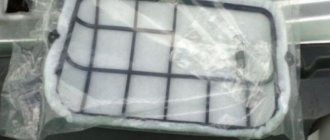Hello. Share a diagram of the parts and devices located under the hood.
- How to glue the hood reinforcement on a VAZ 2115? – 3 answers
- The amplifier has come off the hood of a VAZ 2115 - 3 answers
- Snow gets under the hood of a VAZ 2114 – 2 answers
- VAZ 2114 fuse diagram – 1 answer
- Icons on the instrument panel of the VAZ 2114 – 1 answer
In the center there is a motor, into which air flows through the receiver from the air filter, which is to the right of the engine. To the left of the engine is the windshield washer reservoir. The brake system hydraulic reservoir is located near the air duct above the air filter. The battery is in the lower right corner. The engine cooling system tank is installed slightly higher. The gearbox is located under the engine, under the right side.
Subscribe
to our channel in
Index.Zen
Even more useful tips in a convenient format
So, it all started with my purchase of a car (the choice fell on the VAZ 2107). And as you know, purchasing a car obliges the owner (to begin with) to understand at least a little about its maintenance and, accordingly, repairs. But for me (a novice car enthusiast) everything that was under the hood was a huge secret. Of course, experience is gained over the years, and since I didn’t have the latter (and I knew very little, practically nothing about the “insides” of the car), little by little I began to understand the design features of my Zhiguli. Therefore, so that to my colleagues (novice car enthusiasts) the engine compartment and everything in it does not seem too “dark”, in this article I will tell you what is where and what is responsible for what.
1 - radiator; 2 - battery; 3 - suction pipe; 4 — thermostat; 5 — mounting block of relays and fuses; 6 — air filter; 7 — oil filler plug; 8 — vacuum brake booster; 9 — brake system reservoir; 10 — hydraulic clutch release reservoir; 11 — expansion tank of the cooling system; 12 — washer reservoir; 13 — radiator cap (plug); 14 — ignition coil; 15 — electric fan; 16 — upper radiator hose; 17 — breaker-distributor; 18 — cylinder head cover.
Now about the main thing.
1. Battery – Designed to power electrical equipment when the engine is not running or at low engine speeds. When the engine is running, the power supply is mainly provided by the generator, which also recharges the battery. The battery is one of those items that should be under special attention.
2. Air filter - serves to clean (process) the air entering the engine cylinders. It consists of a housing with an inlet pipe, a cover and a filter paper element. Know that the correct “air” supply to the engine depends on the condition of the filter element. If there is severe clogging or destruction, quite strong losses in power are possible (poor traction).
3. Radiator - serves to remove high temperature from the engine, thereby preserving and reducing wear of engine parts (after all, when the engine is running, temperatures up to 2500 ºС arise, and such a temperature causes strong heating of the parts and their expansion, which can cause intense wear).
Sanding chips before painting
If you decide not to remove all the old paint, but only to update the hood, you need to very carefully remove and treat the places where the stones are chipped.
There are always a lot of them on the hood, because this is one of the most vulnerable places of the car. The chipping area must be covered with masking tape. And only after this the treatment is carried out: washed, dried and treated with a degreasing liquid. After this, we clean the edges of the chips with coarse sandpaper and remove the rust. Then you should clean the chipped area with a brush, rinse thoroughly and treat again with a degreaser.
If the scratch is deep, then it must be puttied. You can use regular aluminum putty. After drying, the treated area is sanded. Application of primer is not necessary when using this putty.
Before painting, we matte the entire remaining part of the hood (rubbing off the glossy layer). And after that we move on to the standard painting procedure, which is described below.
Engine diagram and structure
What's under the hood of a car for dummies?
General view of the engine
Before we begin to consider the issue of the engine design and description of the characteristics, it is necessary to consider the design of the components and parts that are located directly in the main power unit and outside.
Diagram and design of the Samara-2 engine
1 – generator drive pulley; 2 – oil pump; 3 – timing belt; 4 – toothed pulley of the coolant pump; 5 – front cover of the timing mechanism drive; 6 – tension roller; 7 – camshaft toothed pulley; 8 – rear cover of the camshaft drive; 9 – camshaft oil seal; 10 – cylinder head cover; 11 – camshaft; 12 – front cover of camshaft bearings; 13 – pusher; 14 – valve guide; 15 – oil separator mesh for the crankcase ventilation system; 16 – exhaust valve; 17 – inlet valve; 18 – rear cover of camshaft bearings; 19 – fuel pump; 20 – housing of auxiliary units; 21 – ignition distributor sensor; 22 – outlet pipe of the cooling jacket; 23 – cylinder head; 24 – spark plug; 25 – crankcase ventilation hose; 26 – flywheel; 27 – crankshaft rear oil seal holder; 28 – rear crankshaft oil seal; 29 – cylinder block; 30 – oil pan; 31 – oil level indicator (oil dipstick); 32 – crankshaft; 33 – piston; 34 – connecting rod cover; 35 – connecting rod; 36 – crankshaft main bearing cover; 37 – front crankshaft oil seal; 38 – crankshaft toothed pulley.
Also, it’s worth looking at a cross-section of the VAZ-2114 engine:
Cross section of the Samara engine
1 – oil pan drain plug; 2 – oil pan; 3 – oil filter; 4 – coolant pump; 5 – exhaust manifold; 6 – intake manifold; 7 – carburetor; 8 – fuel pump; 9 – cylinder head cover; 10 – camshaft bearing cover; 11 – camshaft; 12 – crankcase ventilation hose; 13 – valve adjusting washer; 14 – pusher; 15 – valve cotters; 16 – valve springs; 17 – oil scraper cap; 18 – valve guide; 19 – valve; 20 – cylinder head; 21 – spark plug; 22 – piston; 23 – compression piston rings; 24 – oil scraper ring; 25 – piston pin; 26 – cylinder block; 27 – connecting rod; 28 – crankshaft; 29 – connecting rod cover; 30 – oil level indicator; 31 – oil pump receiver
General electrical circuit VAZ-2111
- Block lights;
- Sound signal;
- Engine cooling fan electric motor;
- Starter VAZ-2111;
- Accumulator battery;
- Generator;
- Reversing light switch;
- Electric drive for locking the right front door lock;
- Power window relay;
- Starter activation relay;
- Heater motor;
- Micromotor-reducer for heater damper drive;
- Windshield washer motor;
- Washer fluid level sensor;
- Electric drive for locking the left front door lock;
- Right front door power window switch;
- Electric trunk lock;
- Additional resistor for heater fan motor;
- Windshield wiper gear motor;
- Left front door power window switch;
- Electric power window of the right front door;
- Door lock system control unit;
- Outdoor lighting switch;
- Brake fluid level sensor;
- Electric window lifter of the left front door;
- Indicator lamp for turning on the fog light;
- Fog light switch;
- Instrument cluster;
- Rear window heating indicator lamp;
- Rear window heating switch;
- Understeering's shifter;
- Fog light relay;
- Ignition switch;
- Mounting block;
- Illumination lamp for heater control levers;
- Hazard switch;
- Automatic heater control system controller;
- Glove compartment lamp;
- Glove compartment lamp switch;
- Cigarette lighter;
- On-board control system display unit;
- Ashtray lighting lamp;
- Socket for portable lamp;
- Instrument lighting switch;
- Electric drive for locking the right rear door;
- Right rear door power window switch;
- Watch VAZ-2111;
- Electric window lift of the right rear door;
- Brake light switch;
- Electric window lifter of the left rear door;
- Left rear door power window switch;
- Electric drive for locking the left rear door;
- Side direction indicators;
- Parking brake warning lamp switch;
- Luggage compartment lighting;
- Individual lighting lamp;
- Interior lighting;
- Heating system temperature sensor;
- Switches in the front door pillars;
- Switches in the rear door pillars;
- Exterior tail lights;
- Interior tail lights;
- License plate lights;
- Rear window wiper motor;
- Rear window washer motor;
Schematic electrical diagram.
Features of replacing the driveshaft crosspiece of a VAZ-2107: 3 important tips for choosing a part
The schematic diagram retains the sequence and structure of the block diagram, but instead of general functional blocks, the full composition of the elements of the device (device) is shown, depicted in the form of conventional graphic symbols
. Each part is depicted with the number of pins that real parts have, and the connections between the pins are shown in such a way that you can trace all the circuits and connections in detail, and easily understand the processes taking place and the principle of operation of the device.
For ease of reading, next to the symbolic image of the part its alphanumeric designation
, which defines information about the part: functional purpose, location and marking in the diagram. Alphanumeric designations are indicated in abbreviated form and consist of a certain number of letters of the Latin alphabet and Arabic numerals, written sequentially, on one line and without spaces.
Letter designation
taken from the name of the part and indicated by one or two first letters, for example,
R
- resistor,
C
- capacitor,
VD
- diode,
VT
- transistor,
SA
- switch,
XP
- two-pole plug,
EL
- lighting lamp, etc.
Digital designation
indicates the serial number of parts of the same type in the circuit, for example,
R1
,
R2
,
R3
, etc., or
VD10
,
VD11
, etc.
Let's draw a schematic electrical diagram of a table lamp, and for ease of reading the diagram, at the first stage, we will highlight its main elements with green rectangles.
Looking at the diagram, we can say that to power the table lamp, an alternating voltage of 220 V is used, which is supplied through the XP1
and switch
SA1
is supplied to light bulb
EL1
.
That all elements are designed for an operating alternating voltage of 220 V, and that the operation of the lamp is carried out by the position of the contact of the switch SA1
: when the contact is closed, the lamp
EL1
lights up, when it opens, it goes out.
From the diagram it can be seen that the upper terminal of the XP1
connected to the left terminal of the switch
SA1
, the right terminal of the switch contact is connected to the upper terminal of the light bulb
EL1
, and the lower terminal of the light bulb is connected to the lower terminal of
the XP1
.
Switch contact SA1
is shown in an open state, which corresponds to its initial position and the off state of the table lamp. The electrical connection between the terminals of the elements is depicted by segments of horizontal and vertical lines.
And at the same time, the circuit diagram does not give us a complete picture of the table lamp, since it does not indicate information about the design of the lamp and the dimensions of the parts. The fact is that when studying the principle of operation, there is no need to know how, for example, the light bulb is made (size and shape of the bulb, type and size of the base, coil resistance, etc.), what design the switch or plug has
If all this information were indicated on the diagram, they would only distract attention to unnecessary details that are not of fundamental importance
But still, to expand the functionality, some part of the design data of the elements (power, type, method of connection) is indicated on the circuit diagrams, because in some cases it turns out to be the main and only document that is used to guide the manufacture, adjustment, maintenance and repair of equipment.
If we compare the structural and circuit diagrams, then what they have in common is the order of arrangement of the elements and the path of the signal (in our case, electric current), which goes from left to right, i.e. in the direction familiar to ordinary reading. However, on circuit boards, chassis or panels of real devices, elements may be arranged differently, subject to rules aimed at minimizing parasitic connections between individual elements, nodes, and blocks. Therefore, the arrangement of elements inside a real device may not correspond to the circuit diagram.
The considered structural and circuit diagrams are intended mainly for studying the principle of operation, and depending on the type, they provide a visual representation of the functional or elemental structure. To have an idea of the design of the table lamp, the approximate arrangement of the elements and methods of connection between them, use the connection diagram
or
wiring diagram
.
Metallic scraping noise when braking
Bandit cars of the 90s: list. popular cars of the 90s
We have already written about this above, but we should consider squeaking brakes in a little more detail. Brakes sometimes create a characteristic squeaking sound, especially if the pads are wet. Some types of brake pads (especially semi-metallic pads) can squeal or squeal even when they cool down during the winter season. If you hear metallic scraping noises when braking, like someone running a file over rough metal, your brake pads are worn out and your car needs brake service. You shouldn’t hesitate to do this and here’s why.
Worn brake pad
At low speeds, worn brakes work just as effectively, the only difference is an annoying sound. However, at medium and high speeds (50 km/h and above), such brakes may not work at all. In fact, if brakes that are badly worn are "switched on" at speed, there is a risk that the friction material left on the pads will separate from the backing plate. This will cause the brakes to fail and, pressing the pedal, the car will continue to move.
VAZ 2110 engine compartment description
Dear visitors of the “Cars” website! We will be very grateful for your comments on the video clip “VAZ 2110 engine compartment description”; registration is not required for this. We also ask you to let us know if you have any problems playing the video.
Great
But why is it not possible to pull out the whole bunch? My car stalled and wouldn’t start, 21114 124, the state first showed 0328, then it disappeared and started showing 1602, 0338, 0340. I wanted to pull the whole bunch, but there it was. What should I do? I'm guilty of damage at the bottom, where the beam enters the torpedo, I can't reach it with my hands
Don't interfere with the machine's work
very informative. Keep stopping them from working. This is the most interesting thing. Stop something from working
how can I contact you I need your advice if possible call me from me subscribe 79780067322 my name is Evgeniy
Great job, accessible and understandable. We still have a lot of people repairing their iron bunks on their own. A good addition to the repair manual on your channel. Thank you.
romanysh has whatsapp
Thank you so much, thank you so HUGEly Cool video This is exactly the topic I needed, All that’s left is to find a warm garage so that it would be normal to work with electrical tape Romanych, well done, thanks again
What is under the hood of the VAZ 2113
I think it is important that the car looks beautiful not only from the outside, but also from the inside. I mean what's under the hood
I’m not talking about technical characteristics, everyone has their own power and their own parameters, some drove a herd of horses there, and some a small pony, but this pony needs to look great. What is under the hood of the VAZ 2113?
There are parts that need care and attention. I'm planning to install a new receiver soon, it will be slightly larger
Since the car is still in the garage and is ready for all sorts of experimental actions, I cut out a place in the frame there. Then it turned out that I had to abandon what I had started a little, unforeseen worries, you know.
After some time, I returned to the garage and continued what I had started, purchased a primer and applied a thin layer under the hood, let it dry, then painted it yellow. Why yellow, you ask, but I like this color, so sunny and vital, as if nothing under the hood will break. After painting I had to wait a couple more days for everything to dry thoroughly. It is worth noting that you need to select heat-resistant paint, because under the hood there is exposure to high temperatures, sometimes associated with the release of any liquids, such as oil or gasoline, so you need to select durable, special paint. I won’t advertise my paint, but I will say that during the entire run-in period it didn’t even change color, let alone slip. They frightened me with the fact that I would never pass a technical inspection in my life, it’s not true, I passed everything without any particular difficulties, I didn’t give anything to anyone, everything was fair and according to the law.
What to fill in the clutch reservoir of a VAZ 2107?
What should be poured into the clutch hydraulic drive? We are often asked this question, and the answer is very simple. Only brake fluid should be poured into the clutch drive, because it does not compress, thereby not creating depressurization in the system, which in turn can lead to complete failure of the clutch.
Interesting materials:
How to make 3 solution of Bordeaux mixture? How to make an activator from soda? How to make an active link in a story? How to make landscape and portrait orientation at the same time? How to make a non-stick coating on a cast iron frying pan? How to archive files? How to make Bordeaux mixture? How to make Google Chrome open in full screen? How to make pears ripen? How to make your speech beautiful?
Why is it useful to understand auto electrics?
To correctly read a circuit diagram, it is necessary, first of all, to familiarize yourself with the symbols of all its components.
This is what it actually looks like in the diagram. You need to try to read the part markings and then find it in the database, or you need to, based on the diagram and nearby components, try to calculate the approximate characteristics of the element you are looking for. The second group of elements converts electricity into other types of energy.
They are used in switching devices and contact connections, mainly in switches, contactors and relays. Why it is useful to understand auto electrics Even if you are not technically minded or your income allows you not to think about such mundane trifles, replacing an ordinary blown fuse on a long journey will make your life much easier.
For example, take a resistor. How to Read Electrical Diagrams Correctly A schematic diagram is a graphical representation of all the elements, parts and components between which an electronic connection is made using live conductors. In addition, circuit diagrams and wiring diagrams exist and are widely used.
Transformers are also depicted in simplified and expanded, single-line and multi-line methods. As a rule, the screen is connected to the common wire of the circuit.
Now I would like to cover this topic more fully, so that even a beginner in electronics does not have questions. The book provides basic information about the diagrams and drawings of general-purpose electrical installations, the basic rules for their implementation in accordance with the ESKD. When the button is pressed, the circuit is closed through contact 2-SB4, diodes, lamps. In many cases, it requires deep knowledge, mastery of reading techniques and the ability to analyze the information received. For other types of semiconductors, there are their own designations defined by the standard.
In this case, only from an increase in the supply voltage, with drawdowns lower than Ustabilization, the voltage will pulsate in time with the drawdowns. This is true both for radio tubes and for modern microcircuits. Typical examples: the contacts of an electric contact thermometer are directly inserted into the magnetic starter circuit, which is completely unacceptable; in the voltage circuit B, a diode is used for reverse voltage B, which is not enough, since it may be under voltage V K V; the rated current of the diode is 0.3 A, but it is connected to a circuit through which a current of 0.4 A passes, which will cause unacceptable overheating; The signal switch lamp 24 V, 0.1 A is connected to voltage B through an additional resistor of the PE type with an Ohm resistance.
This is important to know, especially when we are just learning to read electrical diagrams. The book provides basic information about the diagrams and drawings of general-purpose electrical installations, the basic rules for their implementation In accordance with the ESKD
The second group of elements converts electricity into other types of energy. Installation diagrams The schematic diagram was discussed above. Therefore, knowledge of electrical circuits is the key to a properly assembled electronic device. How to read electrical diagrams. Lesson #6
Purpose of the hood
The hood of a car (translated into English as the hood of the car) is a cover that protects the engine and other parts located in the engine compartment from damage, dust, dirt, moisture and foreign objects.
In addition to protecting parts located under the hood, the body element performs the following functions:
- Aesthetic. Airbrush designs are applied to the body element, the part is covered with a special film, or the hood is made from visually attractive materials. This has a beneficial effect on the appearance of the car.
- Noise canceling. During operation, the car engine makes a loud sound. A soundproofing layer is installed on the inside of the body cover, which allows you to reduce the sound volume of the operating power unit in the car interior.
- Aerodynamic. Installation of additional air collectors and changing the shape of the body element reduce aerodynamic drag. Thanks to this, with the same fuel consumption, the speed characteristics of the vehicle increase.
1.Main components and systems
Despite the fact that today there are a huge number of different brands and models of cars, almost all of them are built on the same principle. We are talking about passenger vehicles. The car diagram is divided into several parts:
• Vehicle body or supporting structure. Today, the car body is its basis, to which almost all units and components are attached. The body, in turn, consists of a stamped bottom, front and rear side members, roof, engine compartment and other attachments. By attached components we mean doors, fenders, hood, trunk lid, etc. This division is quite arbitrary, since all the parts of the car are, one way or another, interconnected;
• Car chassis. The name speaks for itself and suggests that the chassis consists of many components and assemblies with which the car is able to move. Its main components are considered to be front and rear suspensions, drive axles and wheels. The chassis of the car also includes the frame, to which most units are also attached. The frame is the predecessor of the body.
• With the help of drive axles, the load is transferred from the frame or body to the wheels and vice versa. As for the suspension, many cars have MacPherson strut suspension, which significantly improves vehicle handling. There are also independent (each wheel is individually attached to the body) and dependent (can be in the form of a beam or a drive axle, considered obsolete) suspensions;
• Vehicle transmission. The transmission of a car is usually considered to be the power train. Its main task is to transmit torque from the crankshaft to the drive wheels. In turn, the transmission also consists of several parts, in particular the gearbox, clutch, driveline, differential, axle shafts and final drive. The latter are connected to the wheel hubs;
• Car engine. The main task and purpose of the engine is to convert thermal energy into mechanical energy. This energy is then transmitted through the transmission to the wheels of the car;
• Control mechanism. Actually, the control mechanism itself consists of a brake system and a steering system;
• Vehicle electrical equipment. No modern car can do without electrics, the main parts of which are the battery, electrical wiring, alternator and engine management system. These are only the main parts of the car, each of which provides a system within a system and sometimes more than one. Some parts are worth going into more detail.
VAZ-2111 diagram
The free collection of materials to help auto electricians contains all the necessary documentation on the electrical equipment of the VAZ-2111 car - general circuit diagram, switching system, electronic engine control module, relay block with fuses and other components. The VAZ 2111 car is a station wagon (production from 1998 to 2014), which is a modernized concept of the rear-wheel drive VAZ-2104. Here the wiring diagram for the injector and a number of other components have been slightly changed, as can be seen from the electrical diagrams and harnesses.
Steering
To move normally in a car, the driver needs to make turns, U-turns or detours, that is, deviate from straight-line movement, or simply control his car so that it does not drift to the side. For this purpose, its design provides steering control. This is one of the simplest mechanisms in a car. Let's look at the names of some of the elements below. The steering system consists of:
These devices consist of a steering system that is connected to the front wheels by steering and brakes.
Modern cars use an additional element - power steering, which allows the driver to use less force to turn the steering wheel. It comes in the following types:
Tuning the engine compartment. Engine lighting
In continuation of the materials on tuning, we would like to present an unusual option for decorating the engine compartment of your car.
The source of illumination for the engine elements in this case is LEDs and LED strips. And so let’s imagine, it’s getting dark outside, you approach the car and open the hood, the hot-looking engine shocks the people around you. This effect is created using red LED sources. Beautiful. And at the same time it looks impressive.
In the example presented, the LEDs were installed under the motor protective casing.
The result of such tuning will look impressive on cars that have a protective casing. In the presented example you can see how this was done on a VAZ 2110 engine.
For illumination, an LED strip was used, the length of which is 85 cm. It was also secured to iron corners in the radiator area
When connecting the LED backlight, you should pay attention that all the wiring that you used must be insulated and corrugated. The power source must be connected through a fuse (for convenience, use a plug-in fuse) Also make sure that all wiring is at a certain distance from very hot engine elements
How to insulate yourself
Motorists insulate the car hood with their own hands.
Independent arrangement includes the following stages of work:
Preparation. First, you will need to dismantle the standard hood sound insulation (if available). The operation should be carried out carefully, trying not to damage it. Afterwards, the working surface is thoroughly washed and degreased. Creating templates. You need to make a pattern for the insulation. For these purposes, use old wallpaper or newspapers. It is necessary to carefully cut out the templates, according to which the insulation elements for the hood will subsequently be cut out. The remaining thermal insulation is cut into small strips, which will subsequently be attached to the stiffeners of the body element. Installation of insulation. When performing this operation, you need to stock up on a small roller, glue and insulation. If work is carried out in an insufficiently heated room, use a hair dryer. The adhesive is evenly applied to the degreased working surface, then the insulation is carefully applied from the corner and gradually fixed to the hood (if you stick the element right away, folds and air bubbles may appear). Afterwards, carefully roll over the glued insulation.
Care must be taken as bulges and dents may appear on the outside of the hood due to excessive pressure on the inside of the body element.
When the cold weather ends, the thermal insulation is dismantled. Before new use, the insulation is repaired and reinstalled on the car.
To quickly warm up the car in low temperatures, you need to use thermal insulation of the vehicle's engine compartment. First of all, the warm-up time is reduced, and as a result, fuel consumption is reduced
The engine cools down more slowly, which is important for motorists who use their cars intensively with short stops. For maximum efficiency, not only the hood, but also the air ducts along with the radiator grille are insulated
Do it yourself lighting of the engine compartment on VAZ 2112, 2111, 2110
Many people are faced with the problem that domestic cars do not have engine compartment lighting. This phenomenon greatly disturbs the driver when the engine needs to be repaired at night and the parts are not visible at all. Naturally, a thought immediately arises. Often, many motorists had breakdowns at night and there was no lighting at all. In this case, you had to use flashlights or lighters, which were held in one hand, and the other hand needed to repair the part, which is not a very convenient way to repair.
Everything was done, but time and effort wasted. After such unforeseen situations on the roads at night, it is best to install backlighting on the VAZ 2112, 2111, 2110. So, the work begins.
This article will talk about installing backlighting with LED bulbs or regular halogen ones. To successfully complete the job, you need to have the following tools and materials.
1. Engine compartment lamp from VAZ 2113 -2115 cars 1 pc. 2.Two-core wire, with a cross-section of 1 mm, approximately five meters long. 3.On and off button 1pc. 4. Hanging fuse 1 pc. 5. Flat fuse for five amperes 1 pc.
The installation begins. To install the light bulb, you first need to remove the hood trim, if there is one. Then you need to choose the place where the backlight will be attached. It is best to install on the left side, because that is where all the very important elements of the motor are located. You need to make a mark in this place. You need to make a hole in the hood trim. You need to do this in order to install a light bulb there.
We make a hole and install the entire structure back to see how everything will look, after which we remove everything back. Then, using a thin drill, you need to make a small hole in the hood stiffener rib, into which the lamp fastening element will then be screwed. Then you need to lay the wires. The wire must be pulled under the factory casing. The wiring must be routed to the switch. You need to run the wiring in the plastic part of the hood, after making a hole there. Then we solder all the wires and install them on sealant for installation in a longitudinal hole.
Now we install the light bulb and secure it with wires. One wire must be connected to the positive of the battery; the wire must first be connected to a 5-amp fuse, which will thus increase the life of the light bulb. In this case, the second wire can be easily connected to the hood terminals. In this case, the limit switch will automatically turn off the backlight, even if the button on the dashboard is turned on. Instead of simple and traditional incandescent lamps, it is best to install LEDs or LED strips. In this case, you need to do the work exactly as described above, but the result will be much better. This is how the backlight will look if you install an LED strip.
Car device. Everything about the car
Nowadays, a car is no longer a luxury. Almost everyone can afford to buy it
But often very few people are familiar with the structure of a car, although it is very important for every driver to know what main parts, components and assemblies the vehicle consists of. First of all, this is necessary when some kind of car breakdown occurs, due to the fact that the owner is at least generally familiar with the design of the car, he can determine where exactly the malfunction occurred
There are a huge number of different brands and models of cars, but for the most part, all passenger cars have the same design. Let's analyze the structure of a passenger car.
A passenger car consists of 5 main parts:
- body (supporting structure)
- chassis
- transmission
- internal combustion engine (gasoline or diesel)
- engine management system and electrical equipment
Body
The body consists of four main parts:
- front spar
- rear spar
- engine compartment
- car roof
- hinged components
It should be noted that this division of parts is quite arbitrary, because all the parts are interconnected and form one structure. The suspension is supported by side members that are welded to the bottom. Doors, trunk lid, hood and fenders are more of a hinged component. It should also be noted that the rear fenders are attached directly to the body, but the front fenders are removable (it all depends on the manufacturer).
Chassis
- front suspension
- rear suspension
- wheels
- drive axles
Most often, manufacturers install front independent suspension on modern cars, because
it provides the best control, and also, most importantly, comfort. In independent suspension, all wheels are attached to the body using their own mounting system, which ensures excellent vehicle control.
We must not forget about the now outdated, but still present in many cars, dependent suspension. The rear dependent suspension is basically a rigid beam or a drive axle, if, of course, we consider a rear-wheel drive car.
Transmission
- gearbox or simply gearbox (manual, robotic, automatic or CVT)
- drive axle or axles (depending on manufacturer)
- constant velocity joint or, to put it more simply, cardan transmission
In order to ensure smooth transmission of torque, a clutch is installed on the car, thanks to which the engine shaft is connected to the gearbox shaft. The gearbox itself is needed to change the gear ratio, as well as reduce the load on the engine itself. A cardan drive is necessary to connect the gearbox directly to the wheels or to the drive axle. And the drive axle itself is mounted in the gearbox housing if the car has front-wheel drive. If the car has rear-wheel drive, then the drive axle serves as the rear beam.
Engine
Engine
- This is the heart of the machine, which consists of a large number of different parts.
The main purpose of the engine is to convert the thermal energy of burning fuel into mechanical energy, which is transmitted to the wheels using a transmission.
Engine management system and electrical equipment
The rechargeable battery (AKB) is primarily designed to start the car engine itself. The battery is a permanent renewable source of energy. If the engine is not running, then it is thanks to the battery that all devices powered by electricity operate.
The generator is needed to constantly recharge the battery, as well as to maintain constant voltage in the on-board network.
Engine management system
consists of various sensors and an electronic control unit, which is abbreviated as ECU.
The electricity consumers mentioned above are:
We must not forget about the electrical wiring, which consists of a large number of wires. These wires make up the on-board network of the entire car, which connects together all sources, as well as consumers, of electricity.
Modifications of VAZ-2111
- VAZ-21111 with an opening rear door, station wagon with a 1.5-liter carburetor engine.
- VAZ-21110 is equipped with an injection 8-valve engine with a working volume of 1.5 liters.
- VAZ-21112 station wagon with an injection 8-valve engine with a volume of 1.6 liters and a power of 80 hp. With.
- VAZ-21113 with a 16-valve injection engine with a volume of 1.5 liters.
- VAZ-21114 with a 16-valve injection engine 1.6 liters 89 horsepower.
- VAZ-21116 - 04 all-wheel drive station wagon equipped with a 2-liter Opel C20XE engine with a capacity of 150 horses. It featured enlarged wheel arch cutouts, a redesigned bumper skirt with integrated fog lights and an updated aerodynamic shield over the rear.
- VAZ-2111-90 "Tarzan-2" all-wheel drive station wagon built on the basis of the VAZ-2111, produced since 1999. Like the previous generation of Tarzans, the body of the VAZ-2111 car was placed on a frame from the Niva, the rear suspension of the car was independent.
